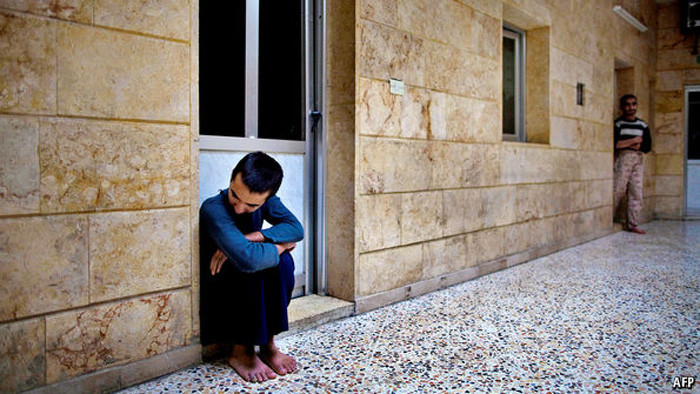WHEN Neda told her children that she might have to kill them, they assented. Such was their suffering after Islamic State kidnapped and enslaved them, along with thousands of other Yazidis, a religious minority, in northern Iraq in 2014. Neda’s husband was taken and presumably killed; her eldest son, just 13 years old, was forced to fight with the jihadists. She shaved off the hair and eyebrows of her two young daughters to make them look boyish and sickly, so that IS rapists might leave them alone. Neda herself was raped, beaten and sold several times before she was bought and freed by relatives last year.
As Neda (not her real name) recounted her ordeal to aid workers at the Mamilyan camp for internally displaced people in the Kurdistan region of Iraq, she showed little emotion, the aid workers said. That is probably a coping mechanism. “If they give in one time and cry, they will not be able to stop crying for a while,” says Rezhna Mohammed, the director of psychological services for the SEED Foundation, which runs a centre in the camp. Neda, though, has only asked for cash (to repay her liberators). Few people in the Middle East seek or receive help for their mental suffering.
Yet the region needs such care. Globally, one in ten people are thought to suffer from a mental disorder at any given time. The rate rises to one in six in areas affected by war. Ailments such as post-traumatic stress disorder and depression are common in the Middle East. War compounds these problems by making treatment harder to obtain. Take Syria, where mental-health care was delivered out of three hospitals in Damascus and Aleppo before the war. One has been destroyed and the other two are now inaccessible, says the World Health Organisation (WHO).
There were only about 70 psychiatrists serving 23m Syrians before the war. Most have fled. In America there are 1.2 psychiatrists per 10,000 people; no Arab country has more than 0.5, and most have far fewer (see chart). The WHO reports that the number of sick is outpacing the already paltry number of psychiatric beds, and the number of day-care facilities is one-tenth of the global median. Even where there are plans to address such deficiencies, they are rarely implemented fully. The upshot is that more than three-quarters of people who need care do not receive it.
Yet the region was once at the forefront of mental-health care. Indeed, the first psychiatric hospitals are thought to have been built during the eighth century in Baghdad and Cairo, where doctors experimented with treatments such as occupational and music therapy. Today’s treatments are often more primitive. Many sufferers of mental illness rely on traditional healers to expel their evil jinnis (spirits). This is accomplished through such methods as whipping patients’ feet, spitting holy fluids into their mouths or praying.
Those seeking professional help risk being ostracised. This is, in part, a legacy of the asylum system that countries such as Egypt adopted in the 19th century. “It was the first step in segregating mental patients,” says Nasser Loza, a former general secretary of mental health in Egypt. One early asylum was in an old royal palace. But over time the facilities became more like prisons, where patients (and, sometimes, dissidents) were locked up and forgotten. People knew little about the places, except that those inside were “crazy”.
From 2006 to 2011 Dr Loza opened up Egypt’s psychiatric hospitals to public scrutiny, to increase pressure for reform. A law passed in 2009 aimed to speed up care, protect patients’ rights and give them more say in their treatment. “We changed as much as we could,” he says. But there are new signs of neglect. Last year 11 patients died at Khanka psychiatric hospital, north of Cairo, because of poor ventilation during a heatwave. At a recent party for staff inside the notorious Abbasiya psychiatric hospital in Cairo, patients were left unattended as a DJ played a song featuring the lyrics, ana fee el laborya (I went mad).
An alternative to asylums is to treat people through local clinics. The WHO points to examples such as Iraq, which rebuilt its mental-health system after the invasion of 2003 to allow for more care outside hospitals. In 2008-09 Jordan used cash from donors to build three local mental-health centres. These were so popular that they led to much broader reforms. Lebanon has followed suit, integrating mental health into primary care. Even Syria has made efforts to decentralise treatment.
But the improvements have been small and fleeting. Consider Iraq. Its mental-health system is still so understaffed that therapy is often performed by those with a mere undergraduate degree, or by foreigners who do not know the culture. Renewed fighting has cut off care—and caused refugees to flood into Jordan, where reforms have been undermined by a lack of funds. In Syria, the government offers threadbare care in loyal areas and none in rebel towns. In the Gulf, where there is more money, relatively little is spent on mental health. The proportion of people in the region who need mental-health care but don’t get it “is as large as ever”, admits the WHO.
Even where therapy is available, many refuse it because of the stigma. The SEED Foundation tries to make things easier at its centre in the Mamilyan camp. Cooking and knitting classes provide an opportunity to talk to residents—and cover for those seeking treatment. It is nothing like an asylum. Still, Neda refuses help. She cries every day and two of her children do not talk. But that doesn’t mean they are crazy, she tells Mrs Mohammed.







Comments